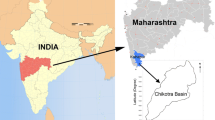Abstract
The electrical resistivity imaging (ERI) technique has been used to calibrate existing successful and dry borehole drilling locations in the Cape Coast Granitoid Complex of the Central Region of Ghana. The area has a low groundwater potential and most of the communities do not have access to potable water. Surface water is generally expensive to treat and is therefore not considered as a good water supply option in such rural and dispersed communities where incomes are low. Supply of water to communities from existing boreholes is inadequate. Therefore, there was the need to construct more boreholes to increase access to potable water to meet coverage targets. Results show that the ERI technique is capable of detecting shallow bowl-shaped conductive zones up to 75 m represented by low resistivity values mainly due to weathered granitoids and/or fractures within the granitoids. Resistivity values typically less than 500 Ω-m obtained between depths of 10–50 m on model resistivity sections accounted for about 80% of successful productive boreholes. Resistivity values in the range 500–1,500 Ω-m represented marginally successful borehole locations which could be suitable for hand-pump installation and values greater than 1,500 Ω-m were confirmation for dry borehole locations.





Similar content being viewed by others
References
Anon, 2004, Small towns water supply and sanitation project in the Western and Central Regions. Technical Report for Water Resources Geophysical Surveys Report, p. 34.
Anon, 2007, ABEM Instructional Manual for SAS 1000/4000 Terameter ABEM Instrument ABS-17266: Sundbyberg, Sweden, p. 135.
Anon, 2008, Water supply of 16 towns of the Central Region. Technical report on analysis of the existing boreholes of the region and optimisation of the location of the implantation sites for new boreholes in the bedrock, p. 27.
Dahlin, T., 1996, 2D resistivity surveying for environmental and engineering applications: First Break, v. 14, p. 275–283.
Ewusi, A., Kuma, J. S., and Voigt, H. J., 2009, Utility of the 2-D multi-electrode resistivity imaging technique in groundwater exploration in Voltaian Sedimentary Basin, Northern Ghana: Nat. Resour. Res., v. 18, no. 4, p. 267–275.
Fernandes, A. J., and Rudolph, D. L., 2004, The influence of Cenozoic tectonics on the groundwater-production capacity of fractured zones: a case study in Sao Paulo Brazil: Hydrogeol. J., v. 9, p. 151–167.
Griffiths, D. H., and Barker, R. D., 1993, Two dimensional resistivity imaging and modeling in areas of complex geology: Appl. Geophys., v. 29, p. 211–226.
Kellett, R., 2004, Mapping groundwater in regolith and fractured bedrock using ground geophysics: A case study from Malawi, SE Africa: Can. Soc. Expl. Geophys. Recorder, v. 32, p. 28.
Kesse, G. O., 1985, The mineral and rock resources of Ghana: A.A Balkema, Rotterdam, 610 p.
Loke, M. H., and Dahlin, T. 1997, A combined Gauss-Newton and quasi-Newton inversion method for the inversion of apparent resistivity pseudosections: Proceedings of 3rd Meeting Environmental and Engineering Geophysics, Aarhus, Denmark, 8–11 September, 1997, p. 139–142.
Loke, M. H., and Dahlin, T., 2002, A comparison of Gauss-Newton and Quasi-Newton methods in resistivity imaging inversion: J. Appl. Geophys., v. 49, p. 149–162.
Louis, F. L., Louis, I. F., and Grambas, A., 2002, Exploring for favourable groundwater conditions in hardrock environments by resistivity imaging methods: Simulation approach and case study example: International Conference on Earth Science and Electronics, Istanbul, Turkey, p. 1–15.
Owen, R. J., Gwavava, O., and Gwuze, P., 2005, Multi-electrode survey for groundwater exploration in the Harare greenstone belt, Zimbabwe: Hydrogeol. J., v. 14, p. 244–252.
Singh, V. S., Krishnan, V., Sarma, M. R. K., Gupta, C. P., and Dhar, R. L., 1999, Hydrogeology of limited aquifer in a granitic terrain: Environ. Geol., v. 37, p. 1–2.
Acknowledgment
The authors are grateful to the Ghana Chamber of Mines for funding this study. The views expressed in the article are however solely those of the authors.
Author information
Authors and Affiliations
Corresponding author
Rights and permissions
About this article
Cite this article
Ewusi, A., Kuma, J.S. Calibration of Shallow Borehole Drilling Sites Using the Electrical Resistivity Imaging Technique in the Granitoids of Central Region, Ghana. Nat Resour Res 20, 57–63 (2011). https://doi.org/10.1007/s11053-010-9129-6
Received:
Accepted:
Published:
Issue Date:
DOI: https://doi.org/10.1007/s11053-010-9129-6




